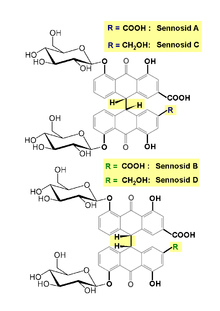 | |
| Clinical data | |
|---|---|
| Trade names | Ex-Lax, Senokot, others[1] |
| AHFS/Drugs.com | Monograph |
| MedlinePlus | a601112 |
| License data | |
| Pregnancy category |
|
| Routes of administration | By mouth, rectal |
| ATC code | |
| Legal status | |
| Legal status |
|
| Pharmacokinetic data | |
| Onset of action | Minutes (by rectum), 6 to 12 hours (by mouth)[3] |
| Identifiers | |
| |
| CAS Number | |
| PubChem CID | |
| DrugBank | |
| ChemSpider | |
| KEGG | |
| Chemical and physical data | |
| Formula | C42H38O20[4] |
| Molar mass | 862.746 g·mol−1 |
| | |
Senna glycoside, also known as sennoside or senna, is a medication used to treat constipation and empty the large intestine before surgery.[1][5] The medication is taken by mouth or via the rectum.[1][6] It typically begins working in around 30 minutes when given by rectum and within twelve hours when given by mouth.[3] It is a weaker laxative than bisacodyl and castor oil.[1]
Common side effects of senna glycoside include abdominal cramps.[3] It is not recommended for long-term use, as it may result in poor bowel function or electrolyte problems.[1] While no harm has been found to result from use while breastfeeding, such use is not typically recommended.[1] It is not typically recommended in children.[1] Senna may change urine to a somewhat reddish color.[1] Senna derivatives are a type of stimulant laxative and are of the anthraquinone type.[1] While its mechanism of action is not entirely clear, senna is thought to act by increasing fluid secretion within and contraction of the large intestine.[1]
Sennosides come from the group of plants Senna.[3] In plant form, it has been used at least since the 700s AD.[7] It is on the World Health Organization's List of Essential Medicines.[8] It is available as a generic medication.[1][6] In 2021, it was the 270th most commonly prescribed medication in the United States, with more than 1 million prescriptions.[9][10] In 2021, the combination with docusate was the 275th most commonly prescribed medication in the United States, with more than 800,000 prescriptions.[9][11] It is sold under a number of brand names including Ex-Lax and Senokot.[1]
- ^ a b c d e f g h i j k l American Society of Health-System Pharmacists (1 January 2008). "Senna". Drugs.com. Archived from the original on 6 September 2015. Retrieved 11 August 2015.
- ^ "Prescribing medicines in pregnancy database". Therapeutic Goods Administration (TGA). Australian Government, Department of Health and Aged Care.
- ^ "Senna(Powdered)". PubChem. U.S. National Library of Medicine.
- ^ Cite error: The named reference
Wald2016was invoked but never defined (see the help page). - ^ a b Hamilton RJ (2010). Tarascon pharmacopoeia (2010 ed.). Sudbury, Mass.: Jones and Bartlett. p. 181. ISBN 9780763777685. Archived from the original on 5 March 2016.
- ^ Khare CP (2004). Indian Herbal Remedies Rational Western Therapy, Ayurvedic and Other Traditional Usage, Botany. Berlin, Heidelberg: Springer Berlin Heidelberg. p. 133. ISBN 9783642186592. Archived from the original on 5 March 2016.
- ^ World Health Organization (2019). World Health Organization model list of essential medicines: 21st list 2019. Geneva: World Health Organization. hdl:10665/325771. WHO/MVP/EMP/IAU/2019.06. License: CC BY-NC-SA 3.0 IGO.
- ^ a b "The Top 300 of 2021". ClinCalc. Archived from the original on 15 January 2024. Retrieved 14 January 2024.
- ^ "Sennosides - Drug Usage Statistics". ClinCalc. Archived from the original on 18 January 2024. Retrieved 14 January 2024.
- ^ "Senna; Docusate - Drug Usage Statistics". ClinCalc. Archived from the original on 18 January 2024. Retrieved 14 January 2024.